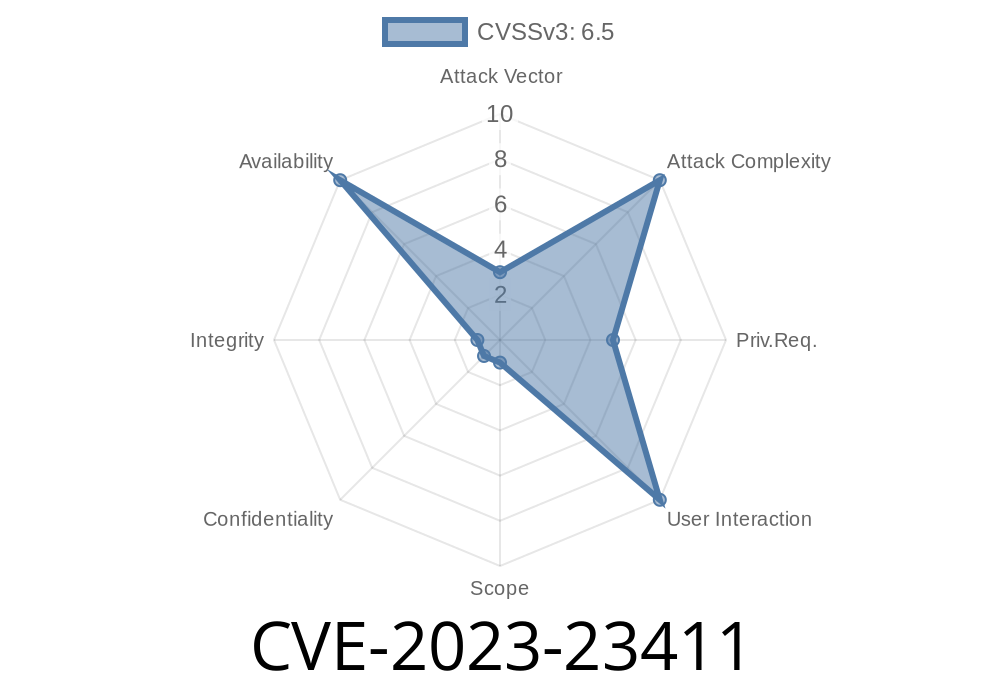Windows Hyper-V, a powerful virtualization platform, is no stranger to vulnerabilities. In this post, we will explore a newly discovered vulnerability - CVE-2023-23411, which allows a malicious attacker to wreak havoc on the system by exploiting a Denial of Service (DoS) attack. We will delve deep into the specifics of the vulnerability, its origin, a code snippet that exemplifies the issue, and how to mitigate the potential damage.
CVE-2023-23411 Overview
The vulnerability CVE-2023-23411 targets a weakness within Windows Hyper-V, the virtualization technology that enables the creation and management of virtual machines. The issue arises when a specifically crafted request is sent to the target system, which causes the Hyper-V host to become unresponsive, ultimately leading to a DoS scenario.
To get a clearer perspective, let's take a look at the National Vulnerability Database (NVD) description of CVE-2023-23411:
"A denial of service vulnerability exists in the way that the Windows Hyper-V Network Switch processes specially-crafted network packets, aka 'Windows Hyper-V Network Switch Denial of Service Vulnerability.' An attacker who successfully exploited the vulnerability could cause the Hyper-V host to become unresponsive. An attacker could exploit the vulnerability by sending a specially-crafted request to the Hyper-V host, which could cause the host to become unresponsive."
Reference: https://nvd.nist.gov/vuln/detail/CVE-2023-23411
Code Snippet
The issue lies within the handling of packets in the Windows Hyper-V Network Switch. The sample Python code snippet below showcases the crafted request that triggers the vulnerability:
import socket
target_ip = "192.168.1.1"
crafted_request = b'\x00' * 4096 # Crafted request message of 4096 null bytes
sock = socket.socket(socket.AF_INET, socket.SOCK_STREAM)
sock.connect((target_ip, 808)) # Assuming the target's Hyper-V listening on port 808
sock.send(crafted_request)
sock.close()
Exploiting the Vulnerability
To exploit this vulnerability, the attacker must first have access to the target Hyper-V host's network. Once they have access, the attacker can use a specially-crafted request (as shown in the code snippet above) to send it to the Hyper-V host, causing the system to halt and enter into a DoS state.
It's important to note that, as the attacker only needs network access to exploit this vulnerability, once they have a foothold on the environment, they could potentially scale and automate the attack, targeting multiple systems to create a more widespread and devastating impact.
Mitigation
The best way to mitigate the risk associated with CVE-2023-23411 is to ensure that your system is updated with the latest security patches provided by Microsoft. By applying the necessary updates, you can protect your Hyper-V environment from falling prey to this DoS vulnerability.
Additionally, you should also implement a robust network segmentation strategy, which minimizes the chances of unauthorized access to your virtual environment. By isolating the systems that access the Hyper-V environment and implementing multi-factor authentication (MFA), you can add an extra layer of security to your virtualized infrastructure.
Conclusion
Remain vigilant and stay updated when it comes to your system's security. By understanding the nuances of CVE-2023-23411, taking the necessary precautions, and ensuring that your environment is patched with the latest updates, you can ward off this potential DoS attack on Windows Hyper-V. Remember, prevention is better than cure, especially when dealing with cybersecurity.
Timeline
Published on: 03/14/2023 17:15:00 UTC
Last modified on: 03/23/2023 16:54:00 UTC
